Intern Weekly Response: Exhibit Review

Every week we’re asking our summer interns to share some thoughts and responses to various experiences and readings. This week we asked them to review an exhibit that they had recently visited. To read more posts from JMM interns, past and present, click here.
~From Intern Elana
For my exhibition review, I have decided to focus on an exhibit that I was able to see at the Smithsonian on our Intern D.C. Day. After going on the gallery tour of the National Museum of the American Indian (NMAI), a fellow guest asked our tour guide which exhibit he would recommend that we visit next and he suggested “Americans.” Thus, I went in with no idea what the exhibit would be about. When I entered the hall, I was greeted with a large room with its black walls covered in bright images of Native Americans in American pop culture, from the Land o’ Lakes butter logo to an Indian motorcycle. This black and white color scheme made the brightly colored images and objects pop and gave the whole exhibition a modern and visually striking appearance. This room made it instantly clear what this exhibition would focus on: the myths and stories of Native Americans as a part of American popular culture: how they came to be and why certain stories are particularly popular. Stepping into the first room made me realize how multi-media focused this exhibition was. The back wall projected video clips, the side walls were covered in images and objects in cases mixed together and two long tables in the center of the room were outfitted with touchscreens that allowed visitors to learn about the images and objects on the surrounding walls. Although I am typically a person who is more drawn to objects, I appreciated the use of multi-media in this exhibit. It allows the visitor to see how narratives permeate so many aspects of how we receive information, from movies and television to books to products you might buy at the grocery store.
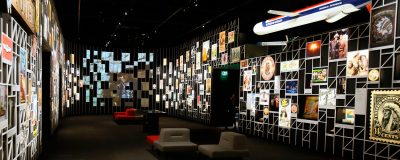
Four rooms jutted off from this center room. Three of the rooms were filled with what one might call an exhibit within an exhibit and the last had a video installation. Each of these rooms told a different popular American story that centered on Native Americans: Pocahontas, the battle of Little Bighorn, the Trail of Tears and Thanksgiving. They attempted to get at the truth of each of these stories and understand why these specific stories became so ingrained in the American narrative. Each room did so effectively by using the multimedia aspect of the exhibition. It was only through interactives, videos, objects, artwork, and text together that the exhibit was able to tell each story and explain how it became so ingrained in the American conscious. Personally, I wish that more than just a video had been included for the Thanksgiving story because the multimedia aspect of the other rooms led to a much greater depth to the stories and a better understanding of how stores such as these become so popular and ubiquitous. However, each of the other rooms did a great job of telling the stories they each focused on. For example, the Little Bighorn room, called “The Indians Win,” used artwork of the battle made by both sides, newspapers, posters, and Native objects to show “Why have Americans been obsessed with this one loss rather than dozens of victories?” and how the image of the “Plains Indian warriors came to represent all Indians.”
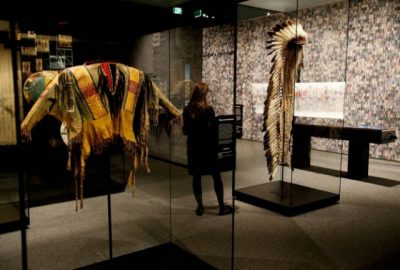
This exhibit made me consider how narratives, not limited to stories about Native people, become ubiquitous in society today. It made me rethink these particular stories, stories that I had heard for years and just accepted, and inspired me to take another look at other stories that are ingrained in the American consciousness. It made me think about where I absorb information from, even from something as simple as the logo on a stick of butter. The message behind this exhibition is incredibly resonant in this world where we are constantly consuming from hundreds of sources. As you might be able to tell, I really enjoyed this exhibit and found it to be highly successful in conveying its story. If you are able to, I highly recommend seeing it in person at the NMAI or experience it online at the link below.
Exhibition website: https://americanindian.si.edu/americans/
~From Intern Ariella
Usually, people go to museums to check out things they’ve never seen before. They don’t go to look at things that they already know.
Americans challenges that idea by flipping it on its head.
Americans is an exhibition at the National Museum of the American Indian (NMAI). Open since January 2018, the exhibit centers on showing visitors images that they’re already familiar with. Most Americans will recognize an Indian Halloween costume, have learned the tune for “Ten Little Indians,” and notice the classic wooden statues outside smoke shops. But the amount of Indian images, terminology, and stories that have infiltrated American culture stretch much farther. Americans seeks to point this out to its audience, and does an extremely successful job.
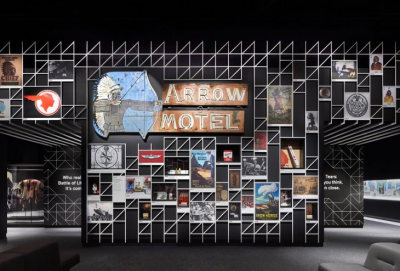
Visitors enter the long, narrow gallery, which is a wing on the NMAI’s third floor. On both sides, from floor to ceiling, are objects. Each has the image or loans its name to Indians.
Directly to the left, by the entrance, is a bright yellow 1948 Indian Chief Motorcycle. Straight ahead, a screen plays the clips from various TV shows and movies featuring Indian characters. Several couches enable visitors to sit and just look around- which they would likely do, if they could easily read the panels by the objects lining the walls.
NMAI’s choices in what to include are interesting to consider. According to its Media Fact Sheet, Americans features nearly 300 objects along the walls. While looking at the items, my main question was: why these? Why did South Park and A Charlie Brown Thanksgiving make the cut, but not the Twilight Saga’s depiction of a werewolf Indian tribe, or Tom and Jerry episodes featuring Indian war cries?
Perhaps the choices were made to highlight instances where the Indian influence was less obvious to casual visitors. For example, there is no sign in the exhibit of the Washington Redskins, a team whose name and mascot are so discussed that both Wikipedia and the Huffington Post have categories devoted exclusively to the topic. But the Seattle Seahawks, whose mascot is likewise inspired by Indians, is included. By making this choice, NMAI is able to inform visitors of a new angle to a topic they thought they knew about. Everyone has heard of the Redskins controversy. The Seahawks label instead asks, “Are all Native American–themed mascots bad? Maybe not,” before explaining that the logo was inspired by art from the North Pacific Coast tribes.
The best aspect of the exhibit was just off of the main gallery. Four small, deep-dive exhibits are included as small wings off the main room. Each focuses on a different, commonly known tale about Indians: Thanksgiving, the Battle of Little Bighorn, the Trail of Tears, and Pocahontas. The rooms walk visitors through the inaccuracies in the widely known stories.
I was least impressed with the Thanksgiving room, which features a five-minute video explaining the holiday’s confused origins. There was nothing wrong with the informative clip, but I didn’t learn anything new. On the other hand, the Pocahontas and Trail of Tears rooms were especially well-done. The Pocahontas room used several different mediums to carry its message across: a public interview video, panels along the walls, and lights pointing out characters on the Capitol’s Frieze of American History.
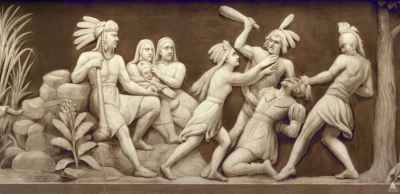
One of the cleverest, and most telling, aspects of the exhibit comes before visitors even walk in. Just the title reveals much of what the gallery’s aims are. It is called Americans – not “American Indians” or “Indians in America.” It is a short, simple, word that the majority of visitors will identify with themselves. In titling the exhibit Americans, NMAI reminds visitors of the way that Indians have been present in American culture from the beginning. Because they are pointed out, they wind up belonging with all Americans.
~From Intern Mallory
For this week’s blog post we were asked to evaluate an exhibition. While there are many museums in the Baltimore-D.C. area, the most recent museum I’ve been to was in Missouri. And while I would love to discuss an exhibition in the area for others to visit, I wouldn’t be able to give a proper evaluation as it has been a while since I visited a museum on my own. So, for this week, I’ll be talking about the Titanic Museum in Branson, MO.
The museum, as the name suggests, discusses the Titanic. At the start of the museum is highlights how the Titanic was made, then discusses the voyage through the iceberg. It has a section dedicated to the passengers, and the museum ended with the discovery of the Titanic in recent years, with the trek down to the wreckage.
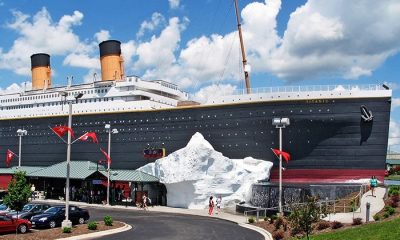
Personally, I really enjoyed the entire museum. I thought that it flowed nicely, starting at the building of the Titanic and continuing through the more recent re-discovery of her. The exhibits mainly housed quotes from passengers and crew, images from onboard the Titanic, and some artefacts (which included items from passengers, some dishware, boarding passes).
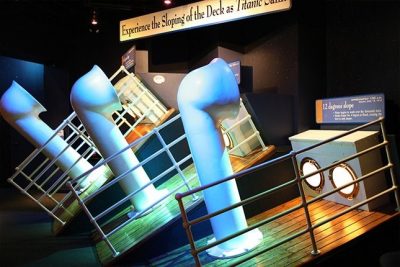
One thing I found to be very interesting was that upon entering the building, everyone was given a boarding pass with a name. This is who you “were” for the time in the exhibits. In the last room there was a wall dedicated to the passengers and crew onboard the Titanic at the time of her sinking, with both survivors and victims listed. This created a very interesting way of connecting the visitors to the people who lived through this event, gaining interest as they walk though and discover more.
One this I found curious was that while the tour was mainly self-guided, with captions to images and text blocks scattered about, there was also an audio tour. While the audio portion wasn’t mandatory, everyone was given a way to access it, and there were numbers throughout the exhibition which would provide more information about certain subjects.

All and all, I really enjoyed my trip. While it was a bit dark at times, I learned so much more than I previously knew. The audio tour portion was, at times, a bit too much – as it could hold up a certain area. But I still think that the audio tour added much more to the entire experience. The few interactives (panels that you could stand on which were angles to show how steep the deck got during the sinking and water as cold as it was that night – 28 degrees) were cleverly places and fun to interact with. There were also small question panels around where you could test your knowledge on the topic discussed in the room which was an interesting way to not only help visitors remember information but also to increase visitor retention time.
But the mystery and narrative being the person who you “are” while walking through really grabbed not just my attention, but also the group that I was with. We all were actively looking through the rooms, trying to look for clues for the fates of our passengers.
The exhibition was very well done, immersive yet not suffocating so. It provided a new outlook into the lives of the passengers, their experiences, their lives after. Personally, I learned a lot and found the exhibit to be very engaging. The way the individual cases were set up were also well done, for the lack of physical items from the ship that survived nothing seemed empty or overcrowded. I also think that the lifestyle and culture of the era was very well represented. It also handled the topic of the tragedy very well, being respectful while also providing all the information they have.
~From Intern Hannah
This is a review of Body Image: Arts of the Indian Subcontinent, featured in the Freer Gallery, one half of the Smithsonian’s National Museums of Asian Art. I visited this exhibit on the JMM Intern’s trip to DC and gave a short summary of my experience in that blog post. However, this was one my favorite exhibits that I visited that day, so I think it deserves an in-depth look.
The exhibit has a strong focus on the human body, specifically, the human body that was accepted to be the most beautiful during the Mughal Empire. Most of the objects in this exhibit were from the period of time when the Mughal Emperors ruled over much what we would now call the Indian Subcontinent. Their reign, which ran from 1526-1858 covered what is now India, Pakistan, Afghanistan, and Bangladesh. This empire was one of the most powerful and prosperous in the world. A lot of art was produced in this period, as appearance meant a lot in this society. The representations of bodies and fashion in this exhibit can tell us a lot about common thoughts and beliefs on the nature of being, gender roles, social ideas, and hierarchies of power at the time. Dress, posture, and conduct were all ways for individuals to show their power, authority, and loyalty. Mughal courtiers often wore beautifully and carefully crafted luxury objects on their bodies, in order to display their sophistication. This Mughal strive for refinement was very tied to the regional king’s authority and inspired both Muslim and Hindu civilians to adopt imperial fashions.
One of my favorite parts of the exhibit was not an object, but the curator’s choice to include magnifying glasses for visitors to use. I definitely utilized this tool to be able to see the intricate patterns and details featured in some of the art in this exhibit.
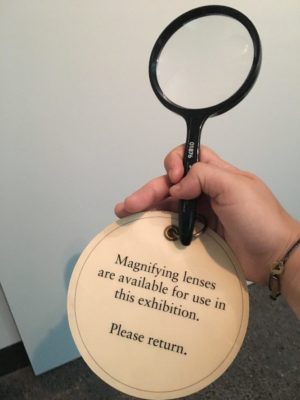
As for objects in the exhibit, I loved this displa6y centered on the use of flowers in Mughal Empire art. The display features a dagger with a beautiful floral motif on the handle, which might have belonged to a Mughal courtier. The flowers are made of rubies, which were valued higher than diamonds, so this would have belonged to someone with means. The middle object is a scent box with painted red and gold lilies, and probably held betel, an aromatic breath-freshener used during intimate moments. The label reads, “in ancient India, sophisticated lovers were always well perfumed.” The third object was a sprinkler, which probably held rose water to be sprayed on guests. The label says it was probably made in Avadh, a north Indian kingdom that emerged towards the end of the Mughal empire, as it was in decline. Also in this room were displays with beautiful jewelry and other adornments. In this first room also lived an imperial scroll that gave beautiful images, and an idea of how these beauty standards were understood and passed on through kingdoms and generations.
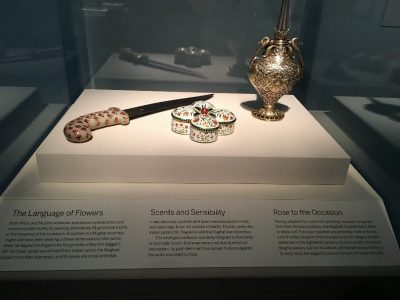
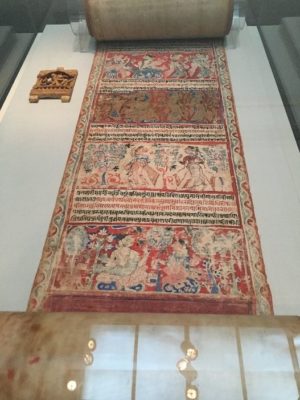
The second room of the exhibit turns away from royalty and towards gods. There is a long list on one of the walls listing the Thirty-Two Body Marks (called Lakshanas) of a Buddha. These markers run from long legs and white teeth, to curls that come out of the head clockwise, and retracted genitals. There were many statues of Buddha in different representations around the room. It was really interesting to see so many interpretations of the same ideal.
I really enjoyed this exhibit and the beautiful objects in it. I have a soft spot for decorative daggers and swords, so I got very excited by the ones featured in the exhibit. I think it is comforting to look at body image standards from another culture and time. It’s great reminder that all beauty standards are socially constructed and are also constantly changing. It is not a short falling to not fit an ideal that is not realistic. It felt really human to be confronted with fashion styles associated with the time and think about what has changed and what has not, in terms of elitism in fashion and the way that mainstream fashion is still greatly influenced by those with power and money. Although ideas about the body, fashion, and gender are very different now than they were in 17th century India, I felt like I could understand the motivation and societal pressure to want to look or present a certain way. Some things never change.
